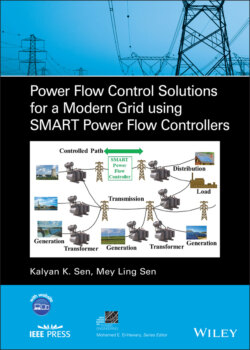Читать книгу Power Flow Control Solutions for a Modern Grid Using SMART Power Flow Controllers - Kalyan K. Sen - Страница 25
1.4.3 Economic Analysis
ОглавлениеA comparison of the sizes and footprints of the world’s first UPFC and an equivalent ST is shown in Figure 1-25. The UPFC applications estimate the project cost to be twice the equipment cost. Conservatively, the assumed project cost of the ST is also estimated to be twice the equipment cost, even though the footprint of the ST is much smaller than that of the UPFC. The Operation & Maintenance (O&M) costs, O&MUPFC, for UPFC are easily an order of magnitude higher than the (O&M) costs, O&MST, of the ST. Since there is very little published data on actual annual operating costs of GTO switches and required maintenance, the O&M costs are ignored for this analysis.
Figure 1-25 World’s first UPFC at the AEP Inez substation (left) versus a comparably rated ST (right).
The life‐cycle cost of a given type of solution (ST or UPFC) is the present value, determined from all cost categories for each design option over a time cycle that is equivalent for all alternatives. Appropriate discount rate for interest is applied. When comparing the ST and the UPFC, one should estimate the life of power electronics inverter‐based UPFC as 15 years and that of the transformer/LTCs‐based ST to be 45 years, although 50 years is a typical life span of power transformers. With alternatives that have unequal lives, it is customary to compare the alternatives over a period of time equal to the Least Common Multiple (LCM) of their lives using the best estimate for future renewal of shorter life alternative life cycle costs. In the case of the ST versus the UPFC, it is estimated that the UPFC costs for years 16–30 and years 31–45 to be same as the costs from years 1–15.
The equivalent future amount (F) at time, t = n, of any present amount (P) at time, t = 0, are related by
(1‐11)
where i is the discount rate or interest rate per period and n is the number of compounding periods. The notation, (F/P, i%, n), is interpreted as “Find F, given P, using an interest of i% over n years.” The factor, (1+i) n , referred to as single payment compound amount, converts P to F.
The uniform series compound amount converts an annual amount (A) to future amount (F) and is related by
(1‐12)
Therefore, the uniform series present worth that converts an annual amount (A) to present amount (P) is related by
(1‐13)
Using Equation (1-13), (P/A, 10%, 45) = 9.8628 and (P/A, 10%, 15) = 7.6061. Therefore, (A/P, 10%, 45) = 1/9.8628 = 0.10139 and (A/P, 10%, 15) = 1/7.6061 = 0.13147.
Consider the baseline designs of an ST and a UPFC of 100 MVA rating, each of which costs $10 M and $50 M, respectively. Therefore, the first cost of the project for the ST is $20 M and for the UPFC is 100 M.
The Annual Cost of UPFC for 15 years with a first‐year installed cost of $100 M
= the Annual Cost of UPFC for 45 years, since a second UPFC will be operational during 16–30 years and a third UPFC will be operational during 31–45 years.
The Annual Cost of ST for 45 years with a first‐year installed cost of $20 M
Annual Savings per year for using an ST, instead of a UPFC
Equivalent Present Value of UPFC for 45‐year period (ignoring O&M costs)
The Economic Analysis of ST versus UPFC over a 45‐year time period is shown in Table 1-1.
